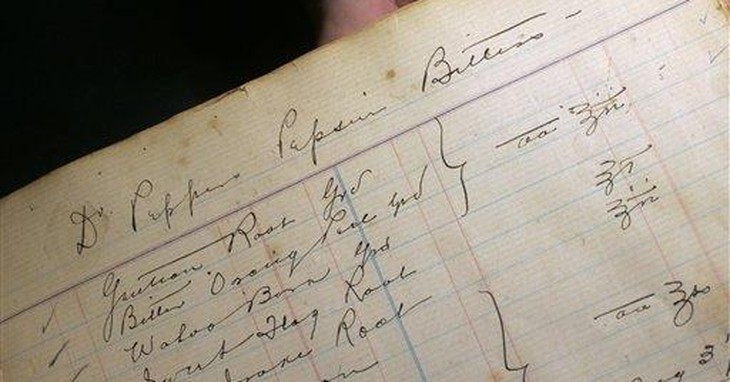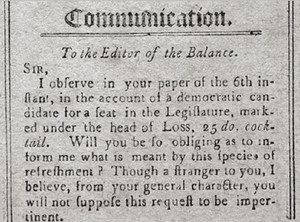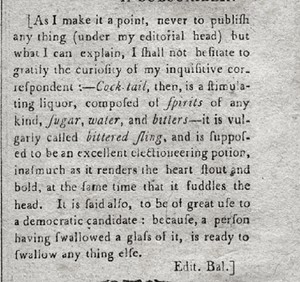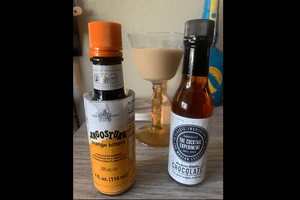(Editor’s Note: Because we know that man does not live by politics alone, but also by film, sports, booze, and barbecue, RedState writers are expanding their base of topics covered. Brad’s column, “Dipsology: Beyond the Basics” is part of that effort and will soon be a RedState VIP exclusive – with the exception of a few special editions on the front page. Click here to become a RedState VIP member and use code SLAGER for a sweet discount! )
When considering the origins of the mixed drink it may strike many at first as a curious concept. After all, hasn’t mankind been at this enterprise of creating spirits for centuries, and would that not carry with it the natural progression of concocting mixed potables using these products? To a degree, yes — but really it appears to have been little more than incorporating an element here and there. Maybe a fruit would be added to a glass, or possibly some other available elixir could have been employed.
The earliest incarnations of these mixed drinks appear to have been little more than the basic shot-and-mix, and most, it seems, saw little fanfare in declaring these combinations as a notably different drink; they simply mixed a preferred element or two. Some taverns in the early colonial period did provide a bare amount of mixtures, such as a fruit or a spice, some even mixing their house version of a punch. It was at this time barware began to develop. A strainer might be used to filter out the seeds from lemons, and early versions of the spout pourer were seen — a stripped quill from a large bird would be pressed through a bottle cork so more measured amounts could be obtained.
As such, “official” origins of cocktails are rather amorphous since what was taking place was a gradual evolution of tastes and techniques. One common colonial drink was Sack, a fortified white wine that was flavored with bitters. This served as the foundation of the mixed elixirs, with bitters a component in these early drinks and continue as a bar staple to this day.

Shaken Origins
The first mention of the term “cocktail” in reference to a potable is believed to be in an almanac lost to time from around 1803. In it, the author(s) referred to a drink made as a curative for one in need of a doctor. The oldest physical record however is found in a newspaper from the Hudson, New York area. In The Balance, on May 6, 1806, an entry about a politician includes a listing — possibly an expense report from his campaign — of a number of consumables, one included being “25 do. Cocktail.”
The following week the paper included a Letter To The Editor from a reader, inquiring about the appearance of this mysterious term. “Will you be so obliging to inform me what is meant by this species of refreshment?”

In so obliging, the editor confirmed for the subscriber what this entailed, along with some caustic commentary. (As seen, the contemporary social media tendency of political snark is hardly a novel entity.)
“Cock-tail is a stimulating liquor, composed of spirits of any kind, sugar, water, and bitters—it is vulgarly called bittered sling, and is supposed to be an excellent electioneering potion, in as much as it renders the heart stout and bold, at the same time that it fuddles the head. It is said, also to be of great use to a democratic candidate: because a person, having swallowed a glass of it, is ready to swallow anything else.”

So, why was the term ”cocktail” designated for such a concoction? There are some varying indicators, none of which actually derive from using a broad feather as a drink stirrer. The most viable explanation is that the practice of this era regarding horses not designated as thoroughbreds had their tails bobbed, or “cocked”, to use the vernacular of the time. From this, any drinks which were diluted or compromised in a manner like those bastardized equestrian bloodlines were so dubbed to be cocktails.
While this may be as close to an origin story as we may find, equally opaque is often the genesis of particular drinks themselves. Pinpointing the arrival of some of the oldest named cocktails can be just as fun and frustrating to nail down. Generally regarded as the oldest known titled recipe is The Sazerac. This is a New Orleans classic and it makes sense, as that city in the early years of this nation was a crucial port, something touched on in last week’s column.
With the Mississippi River growing into a vital trade route New Orleans was a hub of commerce and villainy — or at least vice. With more products passing through the city, the Sazerac became a known classic, with clear roots in France. Comprising the namesake Sazerac cognac, it also includes Absinthe, sugar, and bitters. Over the years whiskey became an acceptable substitute when cognac supplies dwindled, and then a ban on Absinthe meant using similar anise-based spirits like Pernod were called for. Another, Herbsaint, was created in New Orleans as an Absinthe replacement and is now a product of the Sazerac company.
A couple of decades ago the demonization of Absinthe was rolled back and it was once again made available to the marketplace, so today the traditional Sazerac can be enjoyed in its full splendor.
The Bitter Beginnings
As we see, the role of bitters is cemented as a bar staple, and over time it has become an expanded product. There are generally two brands most well known, but in recent years numerous others are coming to market with variations. Bitters is a botanical elixir with numerous plant products involved, the secretive ingredients and blends varying by company. Originally created as an over-the-counter cure-all for everything from digestion aids to seasickness, it is quite literally a holdover from the snake oil days.
The Sazerac employed bitters from a local apothecary shop and as the drink exploded in local popularity the maker, Antoine Amedee Peychaud branded his creation. Peychaud’s Bitters or that made by the Caribbean-based Angostura are regarded as the go-to brands for most bars these days. Bitters not only lives up to its name but possibly exceeds it. Sampling it straight can be a challenge for some and it delivers all the pugnacious flavor that it is designed for — bitters should be regarded as the spice of a cocktail.
The product carries many uses, mostly to lend depth to flavors in a drink and to draw out the complexities of some botanicals in various spirits. It can also be used to tamp down the sweetness in some mixtures or counter the sourness in others. One of the interesting developments is that flavored bitters now is making an emergence. One of the first diversions was Orange Bitters which, in the case of Angostura, is not a flavoring added to its product but comprises a wholly different recipe.
Another new variant is Chocolate Bitters, but do not regard this as a sweetened product. It carries all the alkaline of raw cocoa to lend a new dimension to some drinks involving that flavor, as well as those with coffee/Kahlua elements, and other sweetened liquors of this nature. With some digging, you can also come up with root beer bitters which can lead to a whole other round of experimentation. With this background here are a few worthy mixes that justify nabbing a few bottles of bitters at your bar for diversity.
The Sazerac
As I said, now all the original components are available so you can indulge in the closest approximation to this classic. You are given the leeway of going with whiskey, as opposed to the cognac, and if so doing a Rye is the common selection.
- 2oz. Cognac/Rye Whiskey
- ½ tsp. Sugar, or Simple Syrup
- Absinthe/Pernod to taste
- 2 Dashes Peychaud Bitters
–In a cocktail glass pour about ¼ ounce of Absinthe and coat the glass, add ice, then set aside. In a shaker with ice add liquor, sugar and bitters. Shake enough to dissolve sugar. Pour out the Absinthe and ice and add the shaker contents. Garnish with long lemon peel.
The Tourmaline Cocktail
Regard this as a twist on the classic Manhattan with some interesting nuance involved.
- 2.5oz Bourbon
- ¾ oz Sweet Vermouth
- 2 Dashes Orange Bitters
- Fill martini glass with ice and water to chill. In the shaker add ice and ingredients. Shake until condensation develops. Pour out water and then strain into chilled glass. Garnish with orange peel.

Espresso Lane Cocktail
This is a great after-dinner drink that can invigorate, or completely calm you with multiple servings. The bitters will compensate for the sweetness and make this deeply drinkable.
- 1.5oz Vodka (Van Gogh Espresso, preferred)
- ½ oz Coffee Liqueur
- ½ oz Bailey’s Cream
- 2 Dashes Chocolate Bitters
- 3oz. Cooled Espresso
- In a shaker combine ingredients and strain into a martini glass. If desired, shake cocoa on the surface.
Rancor’s Tooth
In honor of this past Tuesday being Star Wars Day here is a bold themed cocktail that is surprisingly good with a robust character.
- 1.5oz 100 proof Bourbon
- 1oz. Cynar Liqueur
- 1 oz. Sweet Vermouth
- 2 Dashes Chocolate Bitters
- Combine ingredients in a shaker with ice. Shake briefly and pour into a rocks glass. Garnish with orange peel.














Join the conversation as a VIP Member